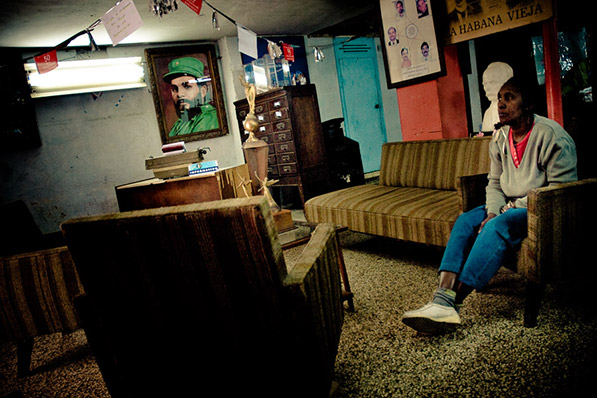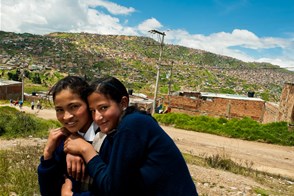Hundreds of Cubans wave the national flags, expressing support for the regime of Fidel Castro and his brother Raul Castro during the annual celebration of the Cuban Revolution's beginning.

Fidel Castro, the former Cuban leader, said in his revolutionary speech: “Revolution is to feel the historical moment, to change what should be changed, revolution is absolute equality and liberty…”

The basic food source for the majority of the Cuban families is the state rationing system. It may cover approximately one third of people's life necessities. The quality of the food is very questionable.

A queue can be seen everywhere in Cuba. Cubans are used to wait patiently to buy a drink on the street, to buy any shortcoming products, they even wait in a queue for the public transport.

Cubans would wish the economic changes but the general country's direction change is out of the question.

Cuban women look through a shop window. The state controlled and planned economy together with the US trade embargo caused the longtime shortage of food, consumer goods and services.

Social conditions and living standards of an average Cuban citizen, who is not a Communist Party member or is not involved in the tourism business (both legally or illegally), remain at a very poor level.

Music is one of the key elements in the Cuban culture. The Cuban traditional music stays beyond the politics. Popular music and dance fill weekends (and working days too) of all Cubans of all ages.

Many Cubans live in large concrete apartment blocks called “Russian buildings”. They were built during the time when Cuba was supported by the former Soviet Union.

Since private ownership is not allowed in Cuba and investments are extremely limited, Cuban industry stays generally underdeveloped.

Young Cuban girls walk embraced down the street during the dusk. The Cuban street is always full and lively, especially in the evening when people meet, talk and enjoy the time of being together.

Many Cuban girls, aware of their natural beauty, offer cheap sex to foreigners hoping that they might marry them later (and take away from Cuba). These girls are called “jineteras”.

Cuba has the biggest number of the classic American cars from the 1950s still in the service. The UN statistics show there are 32 cars per 1000 people in Cuba, comparing to 745 cars in the US.

Men sell clothes pegs at the black market in the centre of Havana. Cubans turned increasingly to the black market to obtain hard-to-find goods, food or medicines.

A Cuban man hurries for a fiesta, holding a bottle of rum, smoking a cigar and carrying a sweet cake. Although the overall situation in Cuba is tough, Cubans never forget to celebrate, to call for a fiesta.

50 years after Revolution
Cuba – 2008-2009
About 50 years after the national rebellion, led by Fidel Castro, and adopting the communist ideology shortly after the victory, the Caribbean island of Cuba is the only country in Americas having the communist political system. Although the Cuban state-controlled economy has never been developed enough to allow Cubans living in social conditions similar to the US or to Europe, mostly middle-age and older Cubans still support the Castro Brothers' regime and the idea of the Cuban Revolution.
During the decades of “Revolution” Cuba has increased its literacy rate to 97 percent (second place in Latin America). Education is free of charge in Cuba but highly qualified professionals earn 20 US dollars per month. There is total safety in Cuba, violence almost does not exist, but freedom of expression is prohibitted and prisoners of conscious can be found there.
Cuba has been successfully resisting to all attempts of changing the system from outside. Since the 1990s Cuba struggles with chronic economic crisis and mainly young Cubans call for the economic changes.


















no comments yet